Pros and Cons of Composting
Composting offers significant environmental and financial benefits, but it also comes with challenges you'll need to manage. On the positive side, you'll reduce methane emissions, create nutrient-rich soil for your garden, and contribute to a circular economy that creates local jobs. Composting also cuts waste management costs and improves soil water retention, reducing your irrigation needs. However, you'll need to monitor moisture levels, control temperature, and prevent pest problems. Proper maintenance requires consistent attention to maintain the right balance of green and brown materials. Understanding the fundamentals of composting will help you maximize its advantages while minimizing potential drawbacks.
This post may contain affiliate links. If you make a purchase through these links, I may earn a commission at no additional cost to you. Additionally, portions of this post may be generated using artificial intelligence (AI) technology. While we strive for accuracy, please be aware that AI-generated content may not always be perfect and should be fact-checked when necessary.
The Spatula Scoops
- Composting reduces methane emissions and creates nutrient-rich soil, but requires consistent monitoring of moisture, temperature, and pest control.
- The process creates jobs and economic benefits but demands space, time, and proper maintenance to be effective.
- While composting improves soil health and supports local agriculture, it can produce odors if not managed correctly.
- Composting reduces landfill waste and supports sustainability, though initial setup costs and learning proper techniques may be challenging.
- The practice saves money on waste management but requires specific materials and knowledge to maintain proper decomposition.
The Environmental Impact of Composting
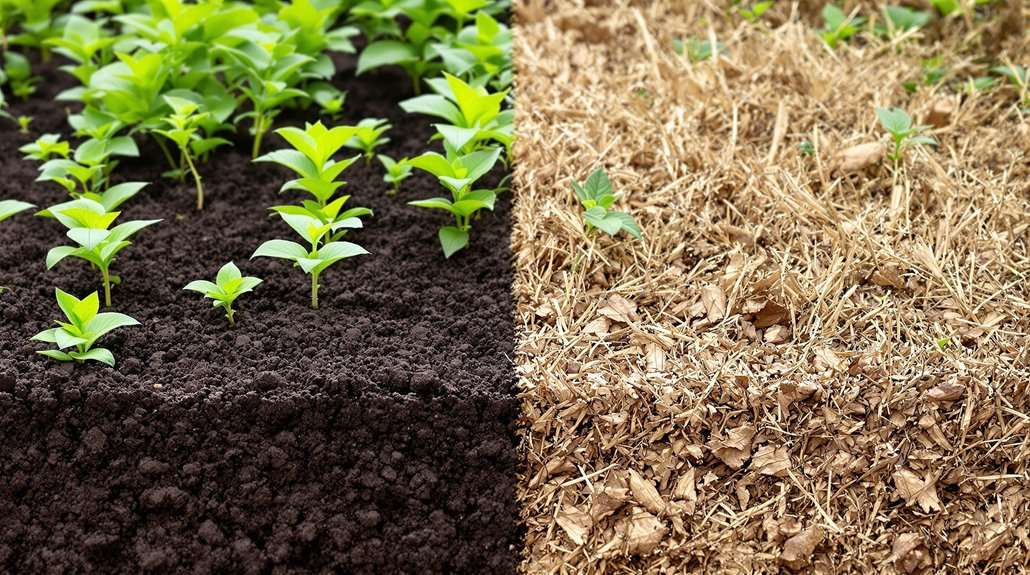
Through composting, you're taking an active role in fighting climate change and protecting our environment. When you compost organic waste instead of sending it to landfills, you're helping reduce methane emissions by more than 50%, as the waste decomposes aerobically rather than anaerobically. Your efforts contribute to a potential reduction of 2.1 gigatons of CO2 equivalent emissions by 2050, assuming global warming is limited to a 2°C rise. For every million metric tons of organic waste that decomposes in landfills, 469 metric tons of CO2 equivalent greenhouse gases are released as methane.
Additionally, the production of palm oil has a significant impact on the environment, leading to habitat loss and greenhouse gas emissions, making sustainable practices crucial.
Your composting activities create multiple environmental benefits you might not realize. You're helping to minimize the 58% of landfill methane emissions that come from food waste while creating a valuable resource that improves soil health. The compost you produce acts as a carbon sink, storing carbon in soils and limiting climate change impacts. It also enhances water retention, reduces erosion, and filters out pollutants like heavy metals and excess nutrients. When you use compost instead of chemical fertilizers, you're supporting local ecosystems and contributing to a circular economy that keeps resources local. This process creates jobs in your community while returning essential nutrients to the soil, making it a win-win solution for both the environment and local economies.
Financial Benefits for Communities
While many people focus on environmental advantages, composting delivers substantial financial benefits to communities. You'll find that composting facilities create twice as many jobs as landfills and four times more than incineration facilities, making them powerful economic drivers. The investment return is remarkable, with composting infrastructure paying back five times more than landfills and seventeen times more than incineration for every dollar invested. Local governments can achieve robust cost savings through organic waste diversion programs. Quinoa, a nutrient-rich food, supports digestive health with its high fiber content, which is also beneficial for composting.
Here are the key financial advantages you'll see in your community:
- Direct cost savings through reduced landfill fees and waste management costs, as demonstrated by Middlebury College's $100,000 annual savings
- Job creation potential, with every million tons of processed compost generating over 1,600 ancillary service positions
- Local economic growth through small business development and workforce education opportunities
Making Better Soil
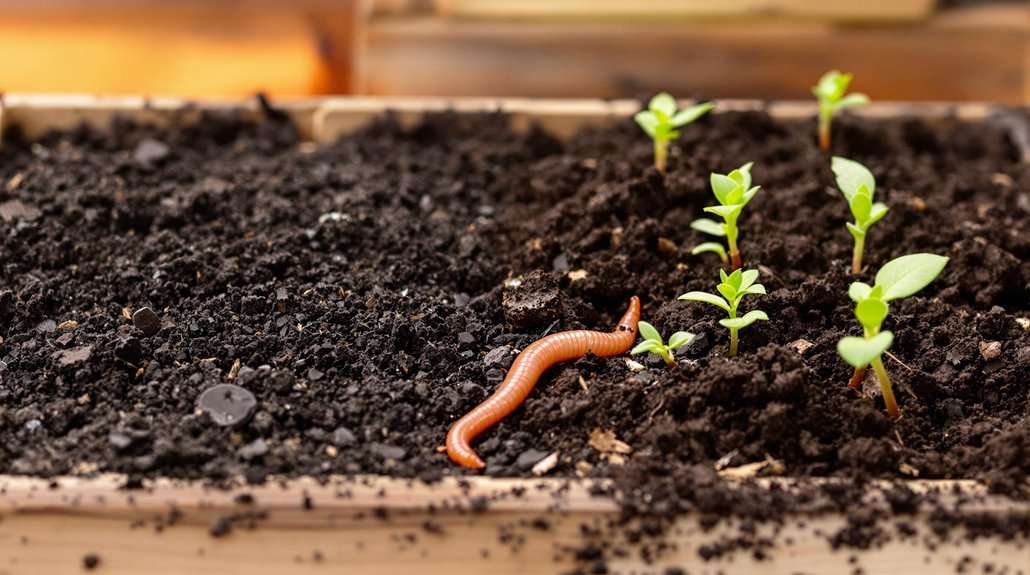
Compost transforms ordinary soil into a thriving ecosystem by improving its structure, nutrient content, and biological activity. When you add compost to your soil, you'll notice it becomes less compacted and drains better, thanks to improved aggregation that creates spaces between soil particles. You'll also find that your soil retains more water, reducing the need for frequent watering.
The benefits don't stop at structure. Your soil will receive a steady supply of essential nutrients like nitrogen, phosphorus, and potassium through slow-release processes. The compost's rich organic matter encourages beneficial microorganisms and mycorrhizal fungi, which help your plants absorb nutrients more efficiently. You'll see fewer problems with soil-borne diseases too, as compost promotes beneficial organisms that naturally suppress plant pathogens. Temperature monitoring can help ensure your compost reaches optimal conditions for killing harmful pathogens and weed seeds. Moreover, using a lemon squeezer in cooking can also lead to efficient juice extraction, which is essential for various culinary tasks.
Beyond your garden's immediate needs, you're contributing to environmental sustainability. The organic matter in compost helps sequester carbon in the soil, while its water-retention properties make your garden more resilient to climate fluctuations. You're also supporting local ecosystems by recycling organic materials and creating healthier soil that can sustain plant life for years to come.
From Waste to Resource
The transformation of organic waste into valuable compost represents one of nature's most efficient recycling systems. When you compost your organic waste, you're not just reducing landfill volume – you're creating a valuable resource that benefits both the environment and your wallet. The process helps minimize greenhouse gas emissions by preventing anaerobic decomposition, while simultaneously producing a nutrient-rich soil amendment. Beneficial micro-organisms thrive in compost, helping to regenerate poor soils naturally.
Converting waste to compost offers three significant advantages:
- Environmental protection through reduced methane emissions, improved soil health, and decreased stormwater runoff
- Economic savings from lower water usage, reduced fertilizer needs, and decreased waste disposal costs
- Resource conservation by enhancing soil moisture retention and limiting energy consumption for waste transport
You'll find that composting creates a sustainable cycle where your organic waste becomes a valuable asset. The finished compost helps sequester carbon in the soil, supports healthy plant growth, and reduces the need for synthetic fertilizers. It's particularly effective in soil remediation projects, where it can cost-effectively treat contaminated soils while improving their structure and water-holding capacity. By composting, you're actively participating in climate change mitigation while conserving essential resources. Additionally, composting can help reduce the carbon footprint of transportation by utilizing local resources, much like the Caspian Sea, the largest inland body of water, which facilitates trade and influences regional ecology.
Urban Agriculture and Food Security
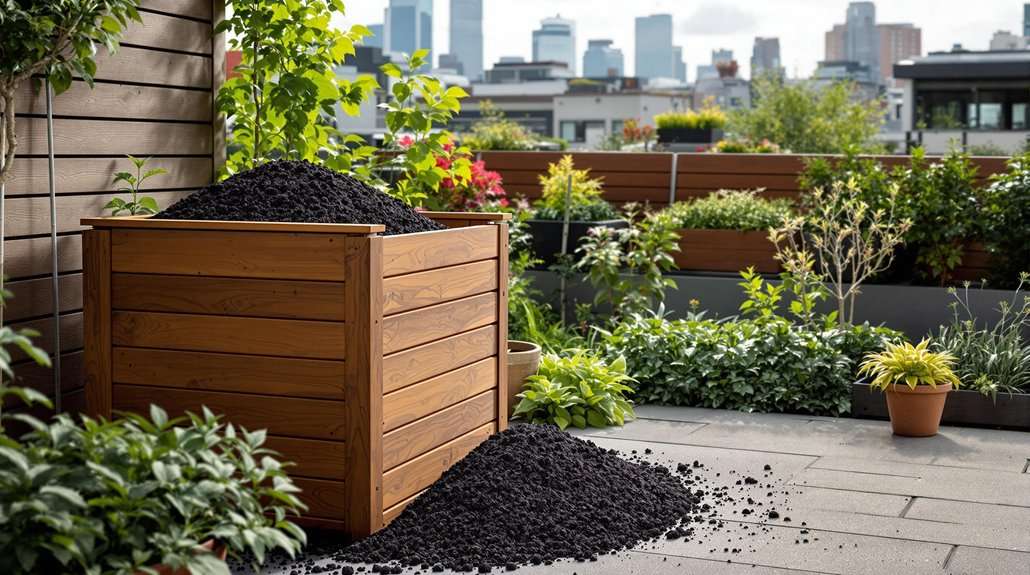
When you compost in urban areas, you're contributing to a pivotal cycle that supports local food security and sustainable agriculture in your community. Your composting efforts help create nutrient-rich soil for urban farms and community gardens, which serve as essential sources of fresh, healthy food in areas that might otherwise lack access. These urban agricultural spaces can produce up to 180 million tons of food annually across the globe. By participating in urban composting programs, you're helping to build resilient local food systems that connect waste reduction, soil health, and food access, especially in neighborhoods where fresh produce can be scarce. Moreover, this process mirrors the biodiversity found in Europe's last remaining rainforest, Peruica Forest, which supports various endangered species.
Growing Local Food Access
Growing fresh produce in urban environments offers a powerful solution for increasing local food access and security. You'll find that urban agriculture greatly improves access to nutritious food, particularly in areas where fresh produce isn't readily available through traditional retail channels. When you participate in local food production, you're contributing to a more resilient food system that reduces transportation costs and supports community health. Low-income areas have significantly fewer supermarkets compared to higher-income neighborhoods within cities.
Consider these key benefits of growing local food:
- You'll have direct access to fresh, nutritious produce that hasn't traveled long distances
- Your community can reduce its dependence on distant food sources, strengthening food security
- You'll help create economic opportunities through local food sales and distribution
While urban agriculture can't completely replace traditional food systems, it plays a crucial role in supplementing your community's food supply. By growing food locally, you're helping to address food accessibility challenges, especially in underserved neighborhoods. The impact extends beyond just food production – you're also supporting biodiversity, reducing food waste, and creating opportunities for nutritional education within your community.
Urban Compost Benefits Communities
Community composting programs serve as powerful catalysts for sustainable urban agriculture and stronger neighborhoods. When you participate in these initiatives, you're not just reducing waste; you're helping create valuable resources for your community. Through the composting process, you'll transform organic materials that would have gone to landfills into nutrient-rich soil amendments that support local food production. The resulting compost is essential for nourishing community gardens and promoting local agricultural initiatives.
You'll find that community composting offers multiple benefits beyond waste reduction. As you work alongside your neighbors at composting sites, you're building valuable social connections and developing a shared sense of environmental stewardship. The economic advantages are significant too – you're helping create green jobs, reduce municipal waste management costs, and support local food systems that keep resources within your community.
Getting Started With Composting
To start composting, you'll need some basic materials including a compost bin or designated area, brown materials like dry leaves and newspaper, and green materials such as food scraps and grass clippings. You'll want to choose a level spot in your yard that's partially shaded and at least 3 feet away from structures, making sure you have enough space for both your main composting area and room to turn the pile. If you're working with limited space, don't worry – you can start with a compact tumbling bin or even an indoor worm composting system that fits under your kitchen sink. Consider partnering with local organizations or businesses that can provide resources and support to help get your composting project off the ground. Having a designated storage space, like a bamboo bread box, can help keep your kitchen organized and make composting more efficient.
Basic Materials Needed
Successful composting starts with gathering the right mix of essential materials. You'll need both "brown" materials rich in carbon, such as dry leaves, straw, and sawdust, and "green" materials high in nitrogen, like vegetable scraps and coffee grounds. These materials work together to create the perfect environment for decomposition, but you'll need to maintain the right balance between them. Building healthy soil is one of the key benefits of proper material selection in composting.
- Brown materials should make up about 2-3 times the volume of your green materials, ensuring proper carbon-to-nitrogen ratios for ideal decomposition
- All materials should be chopped or shredded into smaller pieces to increase surface area and speed up the breakdown process
- You'll want to exclude problematic items like meat, bones, oils, and pet waste, as these can attract pests and slow down composting
While gathering your materials, remember that moisture and air circulation are equally important components. Your compost pile should feel like a damp sponge, neither dripping wet nor bone dry. By maintaining this balance of materials and conditions, you're creating an ideal environment for the microorganisms that do the actual work of composting.
Location and Space Requirements
Choosing the right location for your compost pile involves careful deliberation of four key factors: distance from water sources, available space, accessibility, and compliance with local regulations. You'll need to position your pile at least 200 feet from water bodies and residences, unless you've implemented specific mitigation strategies. Verify your site has a consistent grade with a 4-6% slope for proper drainage. Properly designed facilities must incorporate leachate collection storage that meets NRCS NY313 standards.
| Factor | Requirements | Challenges | Solutions |
|---|---|---|---|
| Water Distance | 200ft minimum | Drainage issues | Install barriers |
| Space Needs | Varies by method | Limited area | Use vertical systems |
| Accessibility | All-weather access | Seasonal changes | Build proper roads |
| Compliance | Local regulations | Complex rules | Keep documentation |
If you're planning a larger operation, you'll need to ponder additional requirements like groundwater monitoring wells and leachate management systems. You'll also want to verify your site has proper stormwater diversion measures and adequate space for both active composting and curing areas. Remember to check your local zoning laws, as they may affect your facility's placement and operation. For long-term success, it's best to secure permanent land access through ownership or extended leases.
Common Composting Challenges
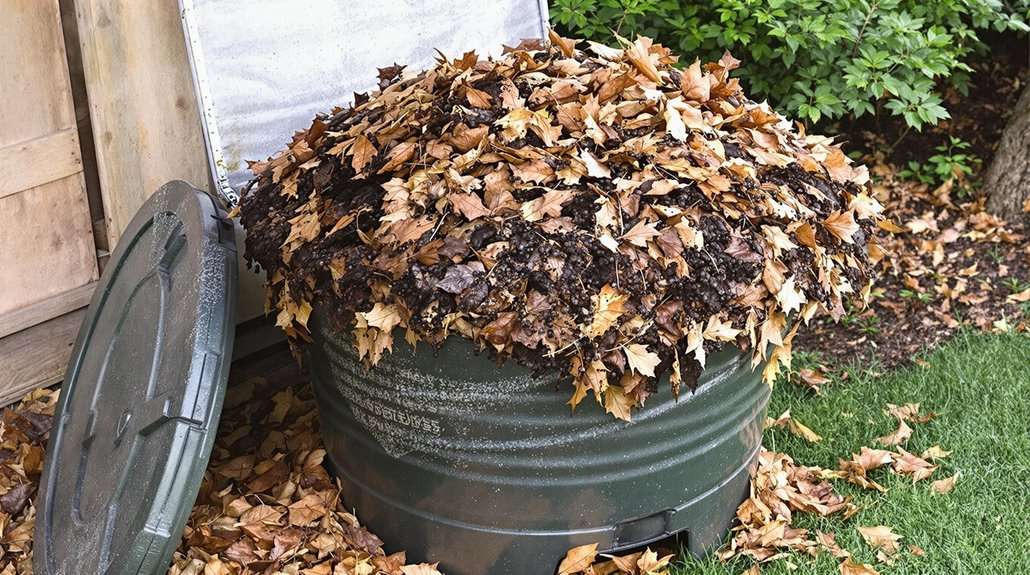
While composting offers numerous benefits for gardeners and the environment, several common challenges can arise during the process. You'll likely encounter issues with moisture control, temperature regulation, and pest management as you maintain your compost pile. When your pile becomes too wet, it can develop foul odors and attract unwanted insects, while insufficient moisture slows decomposition substantially. Creating perfect compost texture requires consistent monitoring and adjustments throughout the decomposition process.
Excessive moisture leading to anaerobic conditions, which you can fix by adding dry materials like straw, sawdust, or shredded cardboard
Temperature fluctuations that affect decomposition rates, requiring regular monitoring to maintain the ideal range of 130-135°F
Pest invasions resulting from improper material selection or pile management, which you can prevent by burying kitchen scraps and avoiding meat products
You can overcome most composting challenges by maintaining proper aeration through regular turning, balancing your green-to-brown ratio, and monitoring moisture levels using the simple fist test. Many gardeners also consider using cage-free eggs as a nutrient-rich addition to their compost piles. If your pile isn't heating up properly, consider increasing its size to at least 3 feet in both height and circumference for ideal decomposition.
Sustainable Living Through Composting
Beyond managing common composting challenges, your composting efforts can substantially impact sustainable living and environmental conservation. When you compost, you're not just reducing waste; you're actively participating in climate change mitigation by preventing methane emissions from landfills and sequestering carbon in the soil.
Your composting practice contributes to multiple sustainability goals. You'll save money on chemical fertilizers while enriching your soil with nutrients that can help it retain 2.5 times more water than traditional soil. This water retention capability means you'll need less irrigation for your garden, contributing to water conservation efforts. Furthermore, you're joining a larger movement that, if adopted nationwide, could reduce emissions equivalent to removing 7.8 million cars from the road. By using eco-friendly food storage options like reusable bags, you can reduce single-use plastic waste and further support your sustainable lifestyle. With only 5% of food waste currently being composted in the United States, there's enormous potential for growth in this sustainable practice.
The Future of Waste Management
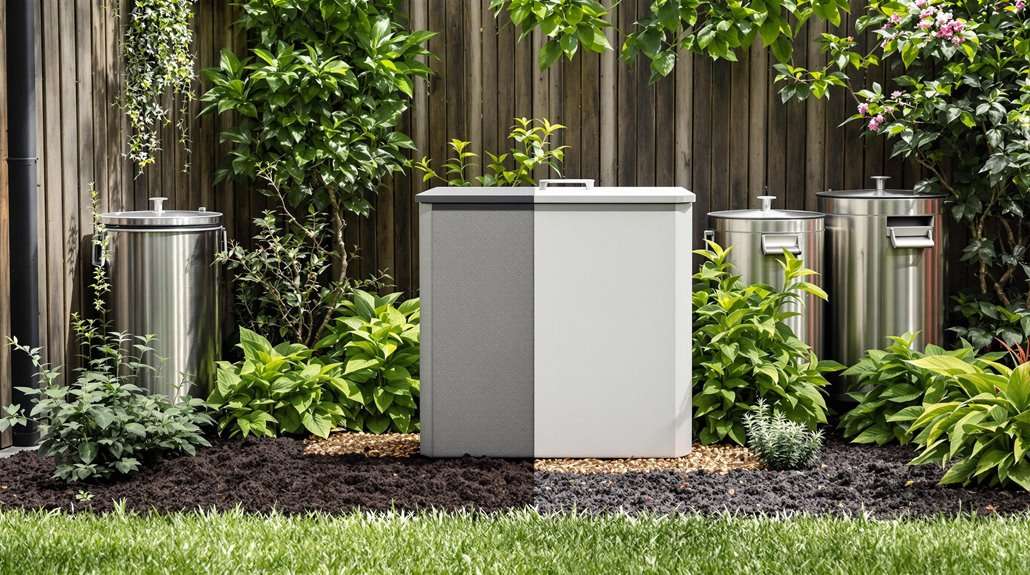
As we move into a new era of waste management, technological innovations and circular economy strategies are revolutionizing how we handle waste. You'll find smart bins equipped with sensors that optimize collection routes, while artificial intelligence systems are making waste sorting more efficient than ever before. These advancements, combined with waste-to-energy technologies, are creating a more sustainable future for your community. Proper waste disposal has become increasingly crucial for protecting public health and the environment. Furthermore, it's essential to adopt responsible practices, such as eco-friendly disposal methods, to prevent environmental harm.
The integration of digital platforms and emerging technologies offers several key advantages for modern waste management:
- Smart waste monitoring systems that'll help you track your waste output and recycling efforts through real-time data collection
- Advanced recycling facilities that can process materials more efficiently, reducing the amount of waste that ends up in landfills
- Waste-to-energy conversion systems that transform your organic waste into usable heat and electricity
You'll see these changes reflected in your community through improved recycling programs and more efficient waste collection services. The future of waste management isn't just about disposing of waste – it's about creating a circular economy where your waste becomes a valuable resource, supporting environmental sustainability while reducing costs and improving operational efficiency.
Frequently Asked Questions
Can Meat and Dairy Products Be Added to a Compost Pile?
While you can technically compost meat and dairy, it's not recommended for home composting. These materials attract pests, create strong odors, and may harbor harmful pathogens that won't break down at typical backyard compost temperatures. If you're determined to compost these items, you'll need a commercial facility or specialized equipment that can maintain temperatures above 140°F to safely process them.
How Do You Know When Compost Is Ready to Use?
You'll know your compost is ready when it's dark and crumbly like rich soil, with a pleasant earthy aroma. Test the temperature – it should be close to the ambient air temperature (around 50°F). Check that there aren't any recognizable food scraps or yard waste visible, and verify the pile has shrunk to about half its original size. For confirmation, try planting some radish seeds – good germination means it's ready to use.
Does Compost Attract Unwanted Wildlife to My Yard?
Yes, your compost pile can attract wildlife, but you'll minimize this issue by following proper composting practices. Keep food scraps buried under 8 inches of soil, maintain a 3:1 ratio of browns to greens, and use enclosed containers with secure lids. You can also deter unwanted visitors by installing hardware cloth around your bin, placing it away from other food sources, and regularly turning the pile to speed decomposition.
What's the Ideal Size for a Backyard Compost Pile?
You'll want your backyard compost pile to be at least 3 feet x 3 feet x 3 feet (one cubic yard) – any smaller and you're just creating a snack bar for local wildlife. The ideal size maxes out at 5 feet x 5 feet x 5 feet; beyond that, you're entering the danger zone of anaerobic decomposition. For most home composters, a 4' x 4' x 4' pile hits the sweet spot, generating enough heat while remaining manageable.
Should I Compost Weeds or Diseased Plants?
You shouldn't compost weeds or diseased plants unless you can maintain a hot compost pile that consistently reaches 140-150°F. At lower temperatures, weed seeds and plant pathogens can survive and spread throughout your garden when you use the compost. Instead, bag these materials separately and dispose of them through municipal yard waste collection, or if allowed in your area, burn them.





